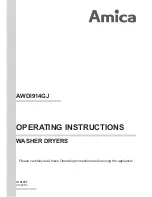
18
How to use washer
■
Care before washing
3
.
Caring before loading
Combine large and small items in a load. Load large items first.
Large items should not be more than half the total wash load. Do
not wash single items.
This may cause an out-of-balance load. Add one or two similar
items.
• Check all pockets to make sure that they are empty. Items such
as nails, hair clip, matches, pens, coins and keys can damage
both your washer and your clothes.
• Close zippers, hooks and strings to make sure that these items
don’t snag on other clothes.
• Pre treat dirt and stains by brushing a little detergent dissolved in
water onto stains like collars and cuffs to help lift dirt.
• Check the folds of the flexible gasket (gray) and remove any
small articles.
• Check inside of the drum and remove any item from a previous
wash.
• Remove any clothing or items from the flexible gasket to prevent
clothing and gasket damage.
2
.
Sorting
To get the best results, sort clothes into loads that can be
washed with the same wash cycle.
Water temperature and spin speed and different fabrics need to
be washed in different ways.
Always sort dark colors from pale colors and whites. Wash
separately as dye and lint transfer can occur causing
discolouration of white etc. If possible, do not wash heavily
soiled items with lightly soiled one.
• Soil (Heavy, Normal, Light)
Separate clothes according to amount of soil.
• Color (White, Lights, Darks)
Separate white fabrics from colored fabrics.
• Lint (Lint producers, Collectors)
Wash lint producers and lint collectors separately.
1
.
Care Labels
Look for a care label on your clothes.
This will tell you about the fabric content of your garment and
how it should be washed.
Wash temperature
Normal machine wash
Permanent press
Hand wash
Sort laundry by...
Soiling
Colour
Wash
temperature
Fabric type
Delicate
Do not wash
NOTE
• Before the first wash, select a cycle (Cotton 60°C, add a half load of detergent) allow the unit to
wash without clothing. This will remove residues and water from the drum that may have been
left during manufacturing.
















































